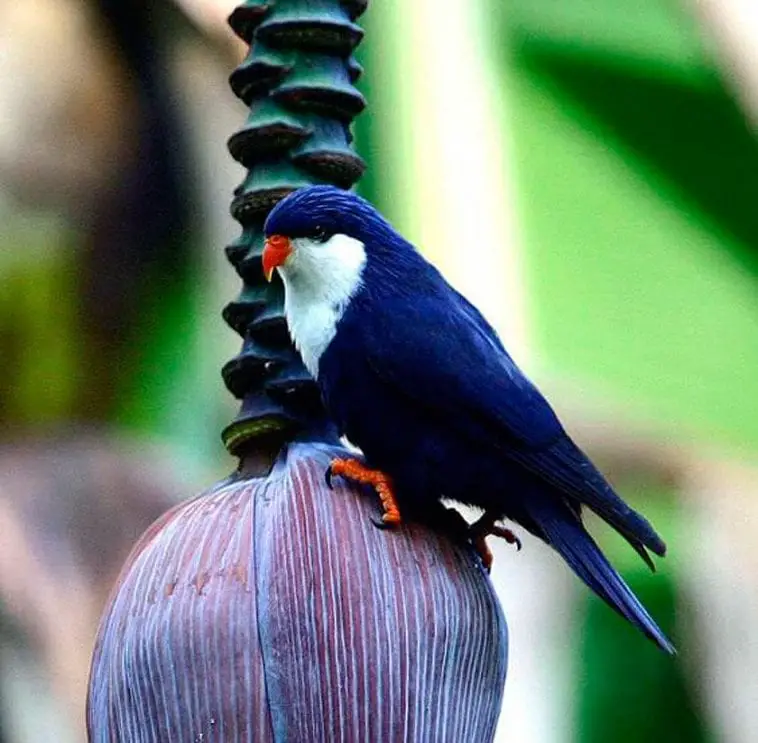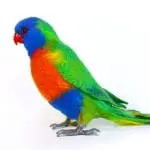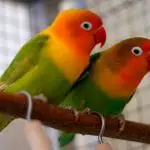Scientific Facts
| Common Name: | Blue Lorikeet |
| Scientific Name: | Vini peruviana |
| Life Span: | 15 to 20 years in captivity |
| Size: | 18 centimeters |
| Habitat: | Woodlands and coconut plantations |
| Country of Origin: | Islands of French Polynesia |
Overview
Lorikeets are the clowns. Similar to a clown, they have a bright red beak. They are noisy and mischievous, that catches people’s eyes.
Lorikeets have 2 main groups; the small Australian lorikeets and the bigger tropical lorikeets. The smaller ones are better pets for their softer bite. They are messy eaters that they require an owner who cleans and allots time for them.
A hand-reared lorikeet is an excellent pet. They can talk after being trained. They should be handled and receive attention. They chatter with their high pitched shrieks.
Physical Description
Blue lorikeets are 18 centimeters longs having a short and rounded tail. They have dark blue plumage and a white area over their lower face, throat, and upper chest. There are light blue streaks of feathers which are erected on top of their head.
Their irises are yellow-brown while their beak is orange. Legs are orange. Both adults of the same sex look similar, but the young don’t have white plumage, and their lower and face is dark grey-blue. In addition, they don’t have dark brown irises, black bill, and their legs are orange-brown.
Distribution and Habitat
These birds were originally endemic to the islands of Polynesia, but they are also found in the Cook Islands. On the Society Islands and archipelago of W Tuamotu. It was later introduced to Aitutaki. These birds inhabit the wooded areas, including the cultivated areas and coconut plantations or gardens having mango trees and flowering banana. They like mixed woodlands having coconut palms, banana trees, tall trees, and shaded trees on Aituaki.
Behavior
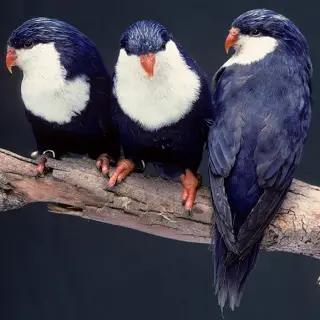
They are seen roosting in the trees of a coconut palm. They rise at dawn. They call and preen before eating. Their flock consists of ten birds or lesser. At daytime, when it is hot, they rest in the shades they find and go on in the afternoon with their feeding. The group flies around to at dusk until it gets dark. Then, at night, they rest on the spaces of the palm leaves.
Diet and Feeding
These birds are not different from other lories or lorikeets because they also eat nectar and pollen. On Rangiroa, they eat coconut flowers. They eat in small groups using their tongue that is brush-like in structure. This tongue laps up the pollen and nectar. When flowers are not opened fully, they use their bills in order to open them. After eating the flowers at one tree, they move to another one calling each other as they fly. Apart from nectars and pollens, also eat leaves, soft fruits, and leaf shoots.
Breeding and Reproduction
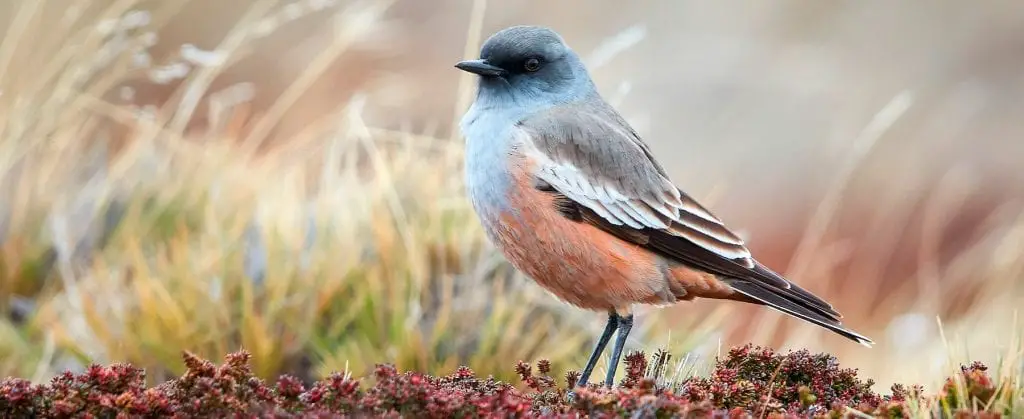
A pair flies for long distances to find a nesting site suitable for them. Then, they build their nests 80 feet above the ground. They keenly look for tree hollows before choosing the right one. They prepare the nest by adding layers of wood dust at the bottom.
During courtship, the male arches his neck and bobs his head, making a whistling sound. The female’s interest depends on how near she is to the nest. After mating, the mother bird lays 2 to 3 white-oval shaped eggs. Then, both parent birds are incubated for twenty-five days. The pairs are long term.
For each season, 3 clutches are laid. Again, both parents feed their hatchlings until moving to the communal roost. The young leave the nest after 7 to 8 weeks but stay with parents until summer. Despite being mature at 9 months, they still don’t breed until they are 2-3 years old.
Colors
Both adults have an orange bill; eyes are yellow or brown. The general color is dark purple or blue. Crowns and occiput are lighter blues. The upper breast to face is white. Juvenile’s underpart is blue or dark grey and no white color. Bills are black, and the eyes are dark brown.
Call
Their calls are high-pitched and repetitious and have 3 syllable whistles. Repetitious and high-pitched. Also three-syllable whistles.
Threat
These birds’ predators are cats, rats, and swamp harrier. Hurricanes are also seen to reduce their number.
Ecology
For food and nesting, they rely on Cocos nucifera, a coconut palm tree. They are very active and tend to be confiding.
Flight
The flocks leave their roost in the morning and begin their journey going to their feeding grounds. The feeding grounds are within twenty miles. They can find their way back by sing paths that seem to follow rivers, hills, or valleys. The traveling flock has sixteen members, and the feeding flock is twenty birds. When all these traveling flocks go to the same landing location, there will be 1000 lorikeets.
To live in the treetops and find food needs a lot of time flying in great distances. They have the advantage of high speed and flights for a long-range because of the fast wing beat they have. They move between thick trees during their short-distance flight. Before the sun sets, they go back to their roots for the night. Their journey continues in the morning.
As Pets
Lorikeet kept in the aviary should be given enough space to fly. They can be kept in a large cage indoors or outdoors. They should be brought outside too. To prevent pressure sores and natural chewing behavior, tree perches are needed. Don’t put plastic perches because they can cause sores in the feet. the toys should not contain fine fibers or cotton as they can cause a problem in the gut.
Metals must be stainless. Outdoor enclosures must be sturdy and strong in order to protect them from predators and the environment as well. Their shelter should have strong roofs, protected sides, and hiding spots like nesting boxes. To easily clean droppings and lessen parasite transmission, solid flooring is ideal. Put the cage away from fire, kitchen or gas, and more. use shredded newspapers for the substrate and lining. Clean and replaced when necessary and as often as possible.
Lorikeets are energetic, animated, and inquisitive. Enough interaction with birds or people is vital to prevent them from getting bored and prevent health and behavioral problems. They can live alone and have socialization with the family.
To enrich the bird’s environment is a way to stimulate their brains. Lorikeets are adapted naturally to hanging upside down and swinging. To mimic the same behavior, swings are good toys. In training your bird, base it on good behavior and ignore the bad ones. Don’t punish them. Stepping up and down is useful for their mental stimulation.
Lorikeets are not fed on seeds. Thus, giving the correct diet is so important. Their diet includes fruit and lorikeet mix. Fruits include melon, orange, pear, apple, and more. they can be kept in the fridge or wrapped in parcels.
Keep your pet’s weight. Don’t let them go obese. To minimize disease, good hygiene must be met. Replace the food twice a day, so there will not be bacterial growth. Put the food in high in the cage so; feces will not contaminate it. Water and food dishes should be washed in soapy and hot water. for their supplement, give calcium too. Don’t feed them with avocado, lilies, and rhubarb.
What You Need When Raising a Lorikeet
Below is a list of all the materials; someone needs to grow his bird. Check this out and find out if you have them.
• A Cage that measures 35”x20”x35” small-medium gauge wire
• A Water bowl
• A Food bowl
• Some Perches
• An Ozpet Litter
• A tidy cage
• A Cage cover
• A Carry cage
• A Golden Lori Rice Formula
• Some Vitamins
• Worming
• An Avicare disinfectant
• Some Lice & Mite spray
• Some Natural perches
• Some Cement perches
• Some Foraging toys
• Lots of Colorful toys
• Ladders
• A Parrot pad
• A Play stand
How to Care
- Housing: a large cage planted aviary having lots of branches for your pet to climb on.
- Diet: Give nectar, either homemade or commercially made. The mixture could be honey, cereal, clean water, and more. fruits would be an apple, sweet corn, pomegranate, etc.
- Enrichment: Give space for bathing as well as branches, ladders, and swings for playing, and climbing.
- Breeding Season is from May to July.
- Nest Box Size: The vertical box measures 4″ x 4″ x 12″ or 10.1cm x 10.1cm x 30.5cm
- Clutch Size: their eggs clutch size is 2.
- The incubation period is 25 days.
- The fledging age is 9 weeks.
- Hatch Weight is 2 grams.
- Peak Weight is 24 to 28 grams.
- Weaning weight is 22 to 25 grams.
What Are Lorikeet’s Behavioral Challenges?
Lorikeets tend to be aggressive when possessions or territory are not respected. This could lead to misbehavior. Therefore, guidance and consistent training are recommended. Here are some challenges to lorikeet’s behavior.
1. Too much chewing. All parrots chew. To customize their tree, they use their beak for their nest to be enlarged. This makes their beak condition good. However, they tend to chew too much. It is not a problem, though, but the owner should give an opportunity for healthy chewings like toys or wood branches and teaching them their off-limits are some ways.
2. Biting. Owners should check this behavior. They use their beak to chase and attack a member in the family that is not their favorite. Proper training is necessary.
3. Screaming. Their voices can be loud, piercing, and metallic. If not trained, they tend to use their voice for shrill calls. The occurrence can be lessened with appropriate training.
Important things about Training your Parrot
Trust must be established. When trust is built, your bird learns to sit on your finger comfortably and wants to play with you. therefore, extend your touch on the body parts. Do it on the nape, face, under the winds, back, and even the feet. with this, you can start to teach tricks after.
Birds expect you to talk back after talking to you. they are great talkers, but words are not enough; thus, handling and touching are their favorites. Relate to them with action and words.
Wing clipping. For lorikeets, clipping is a way to make home confinement safer. In addition, it is used to tame and train them as well. Flight feathers are clipped, but there should not be discomfort or bleeding.
Wing clipping increases the taming process for young and old birds. With this process, the taming process is promoted. It also keeps the bird safe from crash landings.
When clipping, both wings should be clipped. This is for a more controlled flying to the ground. Clippings give enough lift in floating to the ground. Put soft areas for fall areas to avoid bottom and knee injuries.
The training process would be easy but taking some more time. after the bird flies away from you, put it back on your shoulder. When it escapes, pick it up with your cupped hands. Don’t let it wander. It teaches your bird that you and the cage are their safe zones. Then, they will land on you or on the cage and not anywhere.
The next step is talking. Their ability to mimic sounds will be improved by talking, whistling, and singing to them. Talking with them more often is the key. Start by a repetition of their names clearly. The session should only be for 2 to 5minutes only so as not to strain your pet.
How to Change Negative Behaviors
- Foraging prevents the occurrence of destructive behaviors.
- Teach your parrot to talk in order to redirect vocalizations.
- Give fun activities to keep them entertained.
- Do a toy rotation and introduce new ones regularly.
- Keep the TV or radio on.
- Play audios of bird or nature songs.
- Call and talk to them by answering the machine.
- Put the cage near a window. They would love to see other birds.
- Put a lot of branches, fruit trees, and willow.
Common Disease
The most common disease of blue lorikeets as Psittacine Beak and Feather Disease. This is a deadly disease among parrots and lorikeets. It is due to a virus. This disease is in South Australia and other parts as well. This disease affects the beak, claw, and feathers of the bird. It suppresses the bird’s immune system. A symptom is a discoloration on the feathers.
Birds infected die due to secondary infections. This has brought death to many young birds. This is spread through dust, droppings, or secretions. Contact with the virus at the bird’s feeding, watering, and roosting sites transmit the virus.
To prevent, isolate your sick birds from the others. move the water and food dish far from the droppings. Monitor and quarantine your sick bird for 2 months, at least. Disinfect the area, the cage, and everything in the aviary. Shower and change your clothing after handling the sick bird.
Spotting Signs of Illnesses
Check for these behaviors in your pet. It could be an indication of an illness or disease.
1. Your pet stops sitting on perches. Perch sitting is an indication of being active and healthy.
2. Balance problems. Stumbling or shifting could be a sign.
3. Irregular positioning of the body. Tucking head under wings or sitting with a head drop.
4. Decreased activity. They may ignore beak or toenail care.
5. Decreased eating. They may lose their appetite.
6. Change in sleeping habits
7. Losing weight. Weigh your pet regularly.
8. The occurrence of respiratory problems. Breathing rapidly could be a symptom.
9. Eye and ear problems. Discharge or redness, as well as swelling, indicates a problem.
10. Abnormal shape of mouth and beak
11. Feather irregularities
12. Problems in the vent
13. Abnormal feces
14. Feather plucking
How to Deal?
1. Take your pet to the pet.
2. Have your pet undergo tests.
3. Isolate your sick bird from other birds.
Entertaining Your Lorikeet
You should tame your pet. Give them some time as they are still shy about being new to your home. Let them get in your hand. After feeling comfortable, try to take them out of the cage. Talking to them while they stay in their cage will make them get used to your sound. Do not startle them, so walk slowly going to their cage. Pet them regularly. They like being handled and petted. Make it a routine.
Make them feel comfortable being handled. Give them time to spend outside of their cage. They need time to interact with their owners for at least an hour. But, before you release your bird, make sure the environment is safe. Keep them near to you. don’t leave them alone for lots of time. they like being with people. Put the cage in a room where it could spend time with the owner or other people.
Therefore, give sufficient space. Go for the biggest cage, if possible. Give them rattling toys. Toys should be making sounds as they love them, but remove the noise at night. Include foraging toys. It will stimulate them. It mimics scavenging in the wild. Change toys weekly. Give perches too, which are made of wood. A piece of food is entertaining too. Offer them before you leave. Hide it in the cage and let the bird find it.
Again, don’t leave them alone. Buying another one of the same species would be good. Give them full attention. Don’t just focus on one bird. All the toys must be safe that no parts could be swallowed. Don’t let them get out of the cage without your knowledge. They can get injured outside.
Availability: Where to Get One?
Have your blue lorikeet in pet avian specialty stores, pet stores, or bird breeders or adopt one from organizations that rescue avians.
FAQ Section:
What do you feed lorikeets?
They are fed on nectar naturally. In the wild, they eat nectars from native flowers like grevilleas and bottlebrush. They use their brush-like tongue. They are also fed on fruits and berries.
Can lorikeets eat WeetBix?
Yes, they can. Blend fruit juice, whole fruit, cold or hot water, weetbix, and sugar.
Are lorikeets noisy?
Yes, they are especially when they screech continuously as they fly, or while at their roosts and feeding.
Are lorikeets smart?
Yes, they are. They can talk if trained.
Lorikeets are very intelligent, and you can train them to also talk. When they come in large numbers, they can be quite noisy.
Do lorikeets eat a banana?
Definitely, they can eat various fruits, including banana. Don’t give salty, fatty, and processed food for humans.
How can you tell if a lorikeet is male or female?
It is much better to use DNA as some species have the same color for both males and females, making it difficult to identify their sexes.
Where do lorikeets sleep?
They camouflaged behind foliage or dense brush.
Can lorikeets eat eggs?
Animal protein-based foods are toxic to them, and bacterial risk contamination is present.
Can lorikeets eat cuttlefish?
Yes, they can. Cuttlefish contains calcium necessary for birds.
Can lorikeets eat cuttlefish?
Yes, they can. Cuttlefish contains calcium necessary for birds.
Do lorikeets sleep?
Definitely. They have a regular sleep schedule. At daytime, they are active and alert.
Are lorikeets cuddly?
Yes, they are. They love being cuddled too.
They squawk to get attention or comfort. The owner should train the lorikeet to correct the behavior.
Why do lorikeets puff up?
It could mean that he is cold and wants to warm up. This is their way to conserve warmth.
Can lorikeets be kept with other birds?
Keeping lorikeets with other species is quite dangerous as these birds are territorial and don’t want other species joining them.
Do lorikeets mate for life?
Some species stay paired for a long time or their whole life. They are called monogamous.
What trees do lorikeets like?
They are attracted to trees having lots of flowers and seeds, for they like nectars and pollens.
What size cage does a lorikeet need?
The minimum size for one lory is 36″ H x 48″ L x 24″ W. a pair would need 36″ H x 60″ L x 36″ W.

